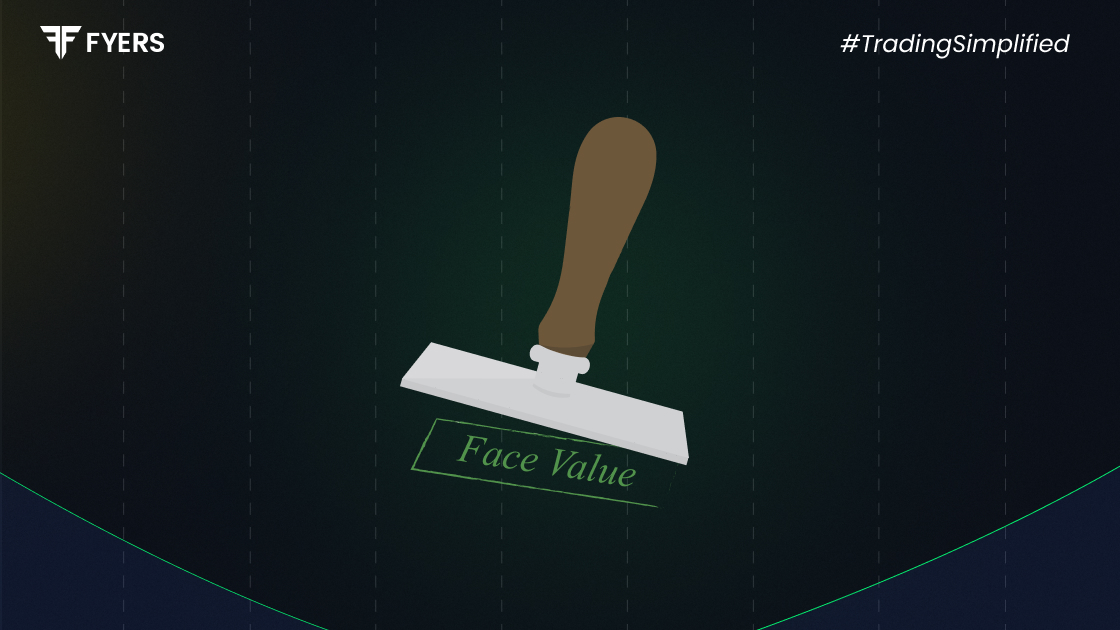

 27 Jun, 2025
27 Jun, 2025
 4 mins read
4 mins read

When you buy a share in the stock market, you’ll often see terms like market value, book value, and face value. While market value shows how much the share is worth in real time, face value tells a different story. It’s a basic yet important concept in understanding how shares and financial instruments are valued and traded.
In this blog, we’ll explain what is face value, how it is calculated, why it matters, and provide real examples from Indian stocks to help you understand its role in the market.
Face value, also known as the nominal or par value, is the original value of a share as stated by the issuing company. It is the value printed on the share certificate or mentioned in the company’s books. This value is set at the time of issue and remains unchanged unless the company performs a corporate action like a stock split or consolidation.
For example, if a company issues a share with a face value of ₹10, this amount represents its base value—not its trading price on the stock exchange.
So, what is face value in shares? It’s the foundation on which key calculations like dividend payouts and share capital are based.
Key Points:
Face value is not the same as the current market price.
It is used for accounting, calculating dividends, and determining share capital.
In India, most shares have a face value of ₹1, ₹2, or ₹10.
This highlights the distinction in face value vs market value, where one remains fixed and the other fluctuates with investor sentiment and trading activity.
Face value is usually pre-determined and mentioned in the company’s financial documents. However, in case it is not directly provided, you can use this formula:
Face Value Formula:
Face Value = Equity Share Capital / Total Number of Issued Shares
Example:
Suppose a company has issued 1 lakh shares and its total equity share capital is ₹10 lakhs.
Face Value = ₹10,00,000 / 1,00,000 = ₹10 per share
This simple calculation shows how to derive face value meaning in stock market accounting.
While face value may not influence daily trading prices, it holds significance in several areas of finance. Here’s the importance of face value across different use cases:
Companies often declare dividends as a percentage of face value. For example, if a company declares a 200% dividend on a share with a face value of ₹5, the dividend amount will be ₹10 (200% of ₹5), not based on the market price.
Face value helps in calculating a company’s authorised, issued, and paid-up capital. This is important for compliance and reporting purposes.
In an Initial Public Offering (IPO), companies disclose the face value along with the issue price. The difference between the face value and the issue price is called the premium. This makes face value in IPO filings crucial for investor transparency.
Changes like stock splits, reverse splits, or bonus issues are calculated based on face value. For example, in a 1:1 bonus issue, if the face value is ₹10, the shareholder gets one additional share of ₹10 for every share held.
Face value is used in balance sheets to show share capital and is important for understanding the financial structure of the company. It also helps investors compare face value and book value, especially when assessing company fundamentals.
Here are some well-known Indian companies and the face values of their shares:
|
Company |
Face Value (₹) |
Market Price (Approx) |
|---|---|---|
|
Infosys Ltd |
₹5 |
₹1,617* |
|
Reliance Industries |
₹10 |
₹1,468* |
|
TCS |
₹1 |
₹3,436* |
|
HDFC Bank |
₹1 |
₹1,976* |
|
ITC Ltd |
₹1 |
₹417* |
These examples of face value show how it remains consistent over time, even though the market price fluctuates daily. It’s a critical reference point in the financial profile of any stock.
Face value may seem like a small detail, but it plays an important role in corporate finance, accounting, and investor understanding. While it doesn’t impact trading prices directly, it helps calculate dividends, understand capital structure, and analyse IPO pricing.
For retail investors, knowing the face value adds depth to evaluating company announcements and financial reports. It also supports comparisons such as face value and book value, or face value vs market value, when analysing a stock.
Face value is the original price set by the company when it issues the share, and it remains constant. Market value is the price at which the share is currently trading on the stock exchange, which changes based on supply and demand.
Yes, it can change during corporate actions like stock splits or reverse splits. For example, if a company does a 1:5 stock split, a ₹10 face value becomes ₹2.
In an IPO, the face value is part of the issue price. If a company issues shares at ₹100 with a face value of ₹10, then ₹90 is considered the premium. Investors use this information to understand the valuation and pricing strategy of the IPO.
Calculate your Net P&L after deducting all the charges like Tax, Brokerage, etc.
Find your required margin.
Calculate the average price you paid for a stock and determine your total cost.
Estimate your investment growth. Calculate potential returns on one-time investments.
Forecast your investment returns. Understand potential growth with regular contributions.